Art therapy methods enhance emotional resilience and self-expression while promoting healing. This article explores the benefits across different age groups, examines various therapeutic techniques, and addresses cultural influences. It also clarifies common misconceptions and highlights innovative approaches that increase accessibility and engagement in art therapy. Practical tips for enhancing creativity and emotional connection are discussed to support personal growth and recovery.
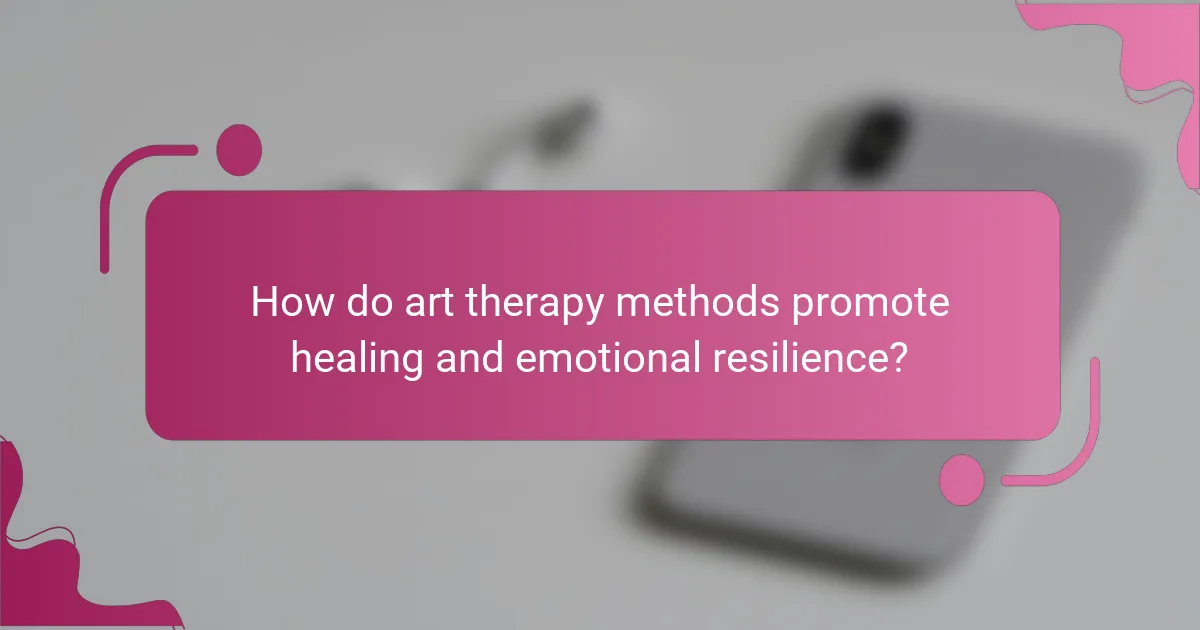
How do art therapy methods promote healing and emotional resilience?
Art therapy methods promote healing and emotional resilience by facilitating self-expression, reducing anxiety, and enhancing coping skills. Creative activities allow individuals to explore feelings and experiences in a safe environment, leading to increased emotional awareness. Techniques such as painting, drawing, and sculpture provide non-verbal outlets for emotions, which can be especially beneficial for those who find it difficult to articulate their thoughts. Research indicates that engaging in art therapy can lower stress levels and improve overall mental health, making it a valuable tool for personal growth and recovery.
What psychological principles underpin art therapy?
Art therapy is grounded in psychological principles that promote healing and self-expression. Key principles include the therapeutic relationship, creativity as a healing tool, and the importance of non-verbal communication.
The therapeutic relationship fosters trust and safety, enabling clients to explore emotions. Creativity serves as a medium for expression, allowing individuals to articulate feelings that may be difficult to verbalize. Non-verbal communication in art therapy can reveal underlying psychological issues, enhancing self-awareness and emotional resilience.
Additionally, the principles of catharsis and symbolism play significant roles. Catharsis allows for the release of pent-up emotions through artistic expression. Symbolism enables clients to convey complex thoughts and feelings visually, facilitating deeper understanding and processing of their experiences.
In summary, these psychological principles collectively support the effectiveness of art therapy in promoting healing and emotional well-being.
Which art therapy techniques are most effective for emotional healing?
Art therapy techniques such as expressive painting, guided imagery, and collage are effective for emotional healing. These methods facilitate self-expression, boost emotional resilience, and promote mental well-being.
Expressive painting allows individuals to convey feelings non-verbally, fostering catharsis. Guided imagery uses visualization to create a safe mental space, aiding relaxation and emotional processing. Collage encourages creativity and reflection, helping individuals explore their emotions through imagery and symbolism.
Research shows that these techniques can reduce anxiety and depression while enhancing overall emotional health. For instance, a study found that expressive arts significantly lowered stress levels in participants.
Incorporating these art therapy methods can lead to profound emotional healing and improved self-awareness.
How does the creative process facilitate self-expression?
The creative process enhances self-expression by allowing individuals to explore emotions through artistic methods. Art therapy methods, such as painting, drawing, and sculpting, provide safe outlets for feelings and thoughts. These activities foster emotional resilience by promoting introspection and personal growth. Engaging in art can lead to increased self-awareness and a deeper understanding of one’s emotional landscape, ultimately facilitating healing.
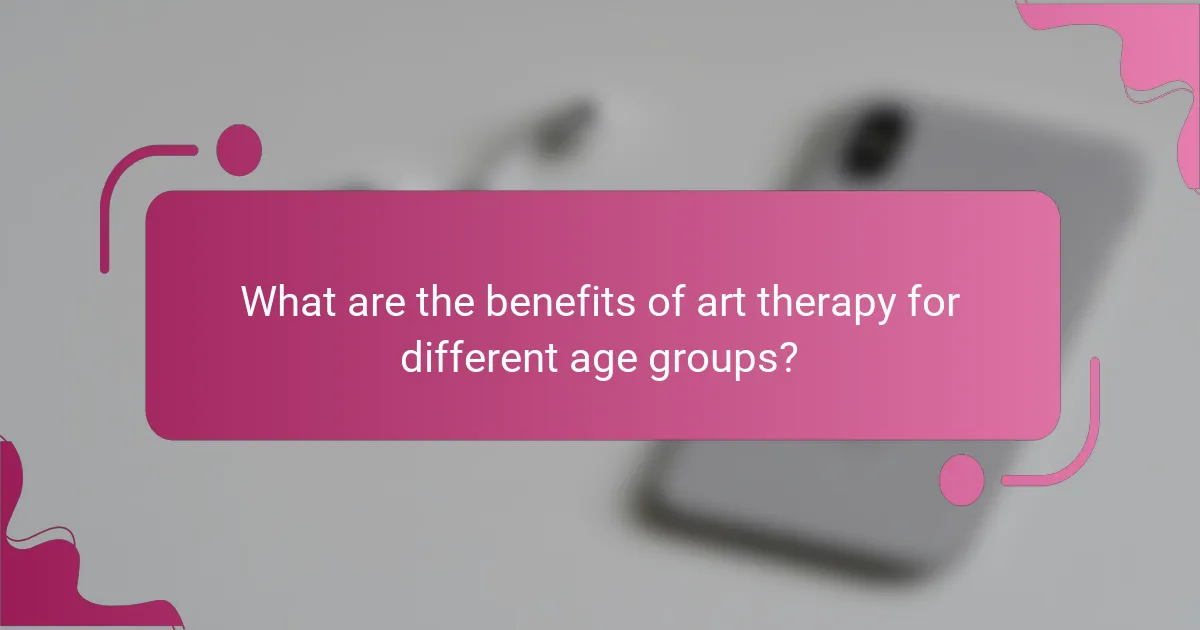
What are the benefits of art therapy for different age groups?
Art therapy offers diverse benefits across age groups, enhancing healing, self-expression, and emotional resilience. Children benefit from improved communication skills and emotional regulation. Adolescents experience enhanced self-esteem and coping mechanisms. Adults find stress relief and personal insight, while seniors enjoy cognitive stimulation and social engagement. Each age group utilizes art therapy methods tailored to their unique needs, fostering growth and well-being.
How does art therapy support children in emotional development?
Art therapy supports children in emotional development by providing a creative outlet for expression and processing feelings. It fosters emotional resilience through methods like drawing, painting, and sculpting, which help children articulate complex emotions. Engaging in art therapy can enhance self-esteem and promote a sense of accomplishment. Research shows that children who participate in art therapy exhibit improved emotional regulation and social skills. By integrating creative techniques, art therapy uniquely addresses emotional challenges, making it a vital tool for childhood development.
What role does art therapy play in adult mental health recovery?
Art therapy significantly aids adult mental health recovery by promoting healing, self-expression, and emotional resilience. It utilizes creative processes to help individuals articulate feelings, reduce anxiety, and enhance self-awareness.
Art therapy methods include painting, drawing, and sculpture, which allow for non-verbal expression. These methods foster a safe space for exploration and can lead to insights about personal struggles. Research indicates that engaging in art can lower stress and improve mood, providing tangible benefits for mental health.
Additionally, art therapy encourages emotional resilience by teaching coping strategies through creative expression. Participants often report increased confidence and improved interpersonal skills, which are crucial for recovery. This therapeutic approach is particularly effective for individuals who find traditional talk therapy challenging.
Overall, art therapy serves as a valuable tool in adult mental health recovery, offering unique benefits that enhance emotional well-being and support personal growth.
How can seniors benefit from engaging in art therapy?
Seniors benefit from art therapy by enhancing emotional resilience, fostering self-expression, and improving mental health. Engaging in creative activities helps reduce feelings of isolation and depression. Additionally, art therapy can stimulate cognitive function and promote social interaction among peers. It offers a safe space for seniors to express complex emotions and experiences, contributing to overall well-being.
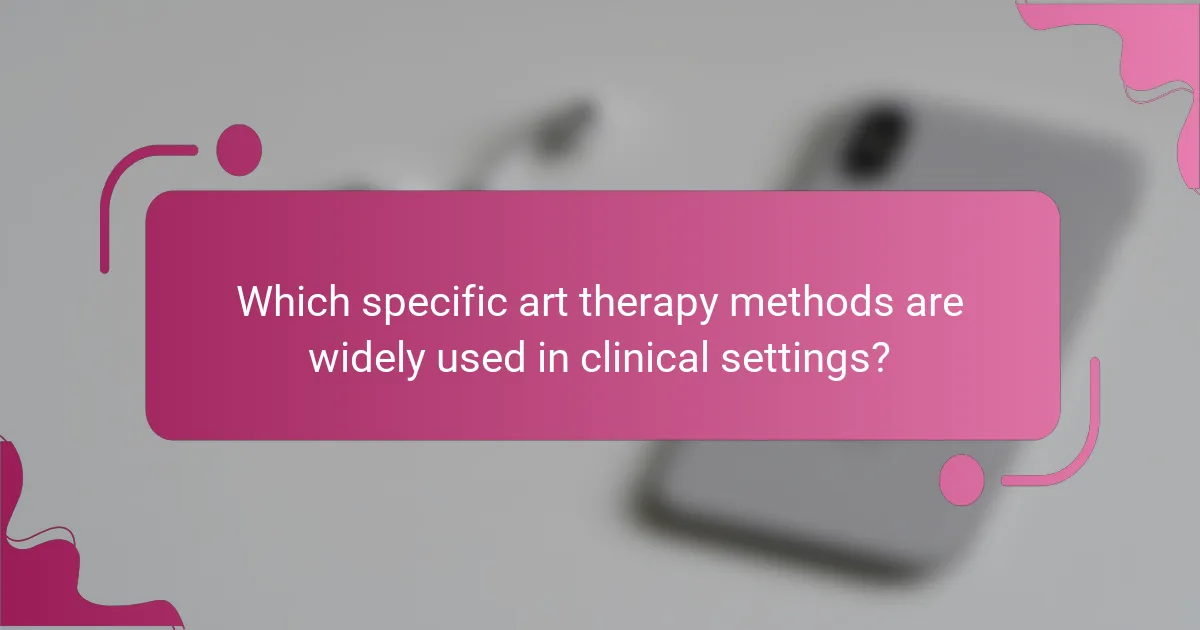
Which specific art therapy methods are widely used in clinical settings?
Art therapy methods widely used in clinical settings include expressive arts therapy, guided imagery, and sand tray therapy. Each method promotes healing and emotional resilience through creative self-expression.
Expressive arts therapy integrates various art forms, such as painting and music, to facilitate communication and emotional processing. Guided imagery uses visualization techniques to promote relaxation and insight. Sand tray therapy allows clients to create scenes using miniature figures, enabling exploration of emotions and experiences.
These methods cater to diverse needs, enhancing therapeutic outcomes by fostering self-discovery and emotional growth.
What is the significance of guided imagery in art therapy?
Guided imagery in art therapy enhances emotional expression and promotes healing. This technique uses visualization to help clients access their feelings and creativity. It fosters a safe space for exploration, allowing individuals to confront trauma and stress. Studies show that guided imagery can reduce anxiety and improve emotional resilience. By integrating imagery with artistic expression, clients can manifest their inner experiences visually, leading to profound insights and personal growth.
How does expressive arts therapy differ from traditional art therapy?
Expressive arts therapy focuses on the creative process for healing, while traditional art therapy emphasizes the final artwork. Expressive arts therapy integrates multiple artistic forms, such as music, dance, and drama, to enhance emotional expression. In contrast, traditional art therapy primarily uses visual arts like painting and drawing. This difference in approach fosters a broader exploration of emotions in expressive arts therapy, promoting holistic healing. Traditional art therapy typically aims for self-reflection through the analysis of visual art.
What role does group art therapy play in community healing?
Group art therapy fosters community healing by encouraging connection, self-expression, and emotional resilience. Participants share experiences and create art, which can lead to collective healing and understanding. This method enhances social bonds, reduces isolation, and promotes empathy among individuals. Research indicates that group art therapy can significantly improve mental health outcomes, making it a valuable tool in community settings. Additionally, it provides a safe space for individuals to explore their emotions and experiences creatively, which can be transformative for communities facing trauma.
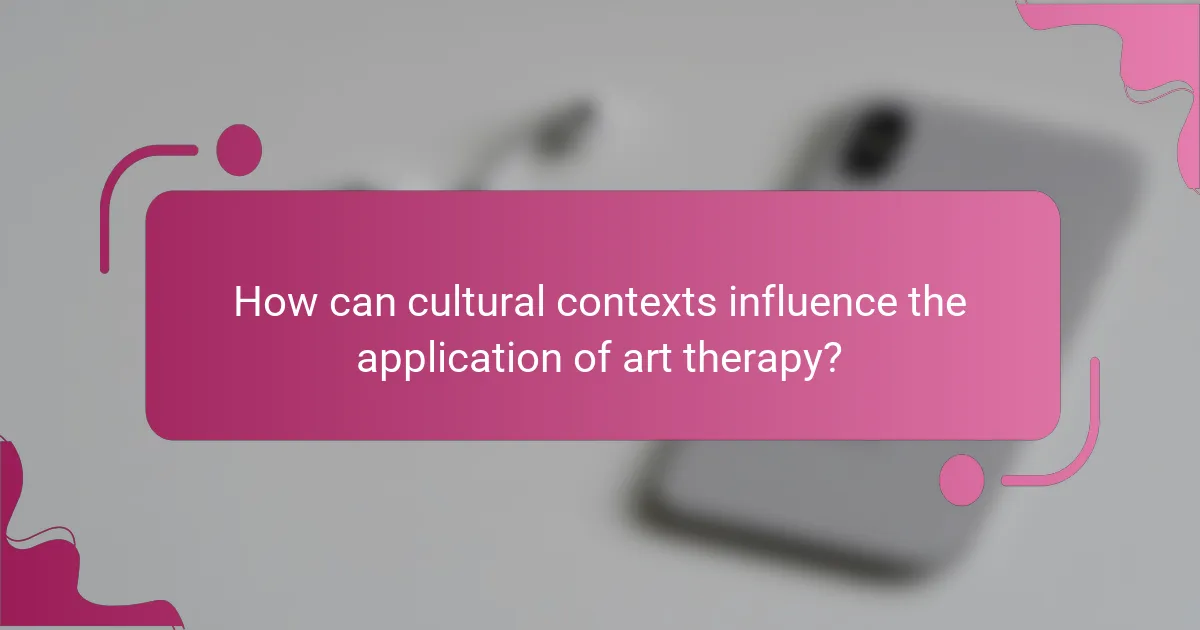
How can cultural contexts influence the application of art therapy?
Cultural contexts significantly influence the application of art therapy by shaping the themes, symbols, and methods used in therapeutic practices. For instance, different cultures may prioritize community-oriented approaches or individual expression based on their values. Art therapy can reflect cultural narratives, allowing individuals to process emotions and experiences in a culturally relevant manner. Additionally, the interpretation of art varies across cultures, impacting how clients engage with the medium and the therapeutic process. This cultural sensitivity enhances emotional resilience and promotes healing by validating diverse experiences and expressions.
What unique challenges do therapists face in multicultural environments?
Therapists in multicultural environments face challenges such as language barriers, differing cultural norms, and varying perceptions of mental health. These factors can hinder communication and understanding between therapists and clients. Cultural sensitivity is essential for effective therapy. Therapists must adapt their art therapy methods to respect and incorporate clients’ cultural backgrounds, ensuring that the therapeutic process is relevant and meaningful. This adaptability can enhance emotional resilience and self-expression among diverse populations.
How do local art traditions shape therapeutic practices?
Local art traditions significantly influence therapeutic practices by integrating cultural expressions into healing methods. Art therapy often incorporates traditional techniques, such as indigenous storytelling or community art projects, enhancing emotional resilience. These culturally rooted practices foster self-expression, allowing individuals to connect with their heritage while promoting mental well-being. For instance, using local materials in art-making can deepen the therapeutic experience, making it more relatable and impactful. This approach not only validates individual experiences but also strengthens community bonds through shared artistic expression.
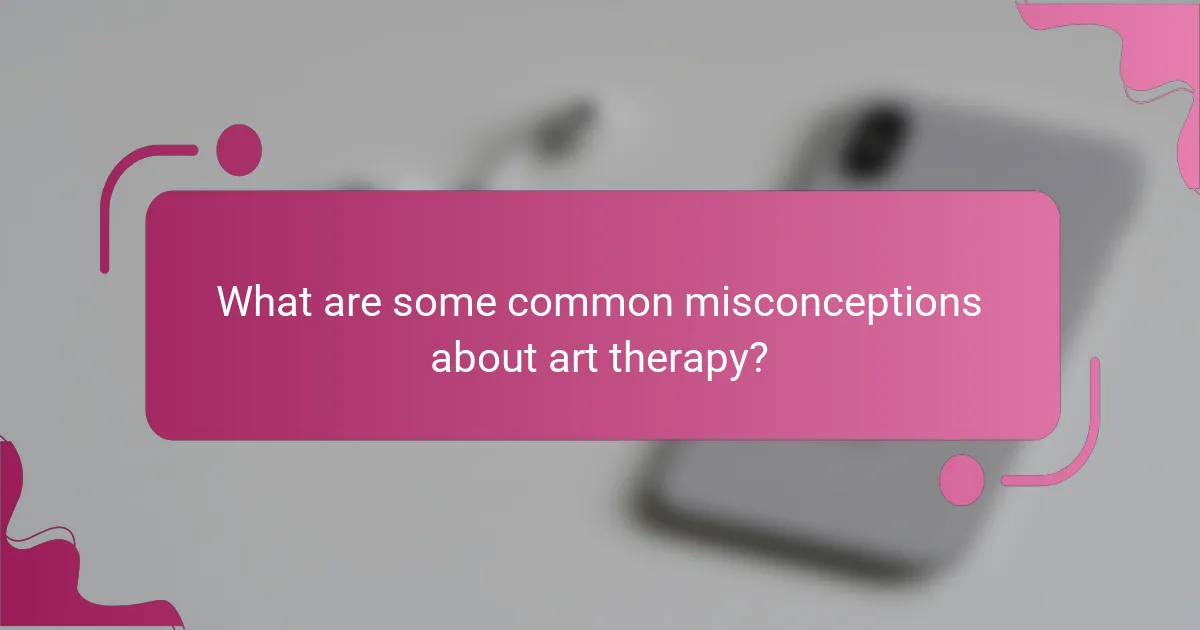
What are some common misconceptions about art therapy?
Many misconceptions about art therapy exist, often diminishing its effectiveness. One common belief is that art therapy is solely for artists or those with artistic talent. In reality, it is accessible to everyone, regardless of skill level. Another misconception is that art therapy is only about creating art. It actually involves a therapeutic process that promotes healing and emotional expression. Some people think it is a quick fix for mental health issues, but true emotional resilience takes time and commitment. Lastly, there is a notion that art therapy is not as effective as traditional therapy methods. However, numerous studies show its positive impact on mental health, enhancing self-awareness and coping skills.
Why do some people doubt the efficacy of art therapy?
Some people doubt the efficacy of art therapy due to misconceptions and lack of empirical evidence. Critics often argue that art therapy lacks standardized protocols, making it seem less credible than other therapeutic methods. Additionally, anecdotal experiences can overshadow scientific studies, leading to skepticism. Some individuals may also perceive art therapy as merely recreational rather than a valid therapeutic approach. This perception can stem from unfamiliarity with the techniques and outcomes associated with art therapy, which include improved emotional resilience and self-expression.
How can understanding art therapy improve client engagement?
Understanding art therapy enhances client engagement by fostering emotional expression and building trust. Art therapy encourages participants to communicate feelings non-verbally, making it easier for them to explore complex emotions. This method promotes a safe environment where clients can connect with their inner thoughts and experiences. As a result, clients often feel more invested in their therapeutic journey, leading to improved outcomes. Additionally, utilizing various art forms can cater to individual preferences, further enhancing engagement and participation.
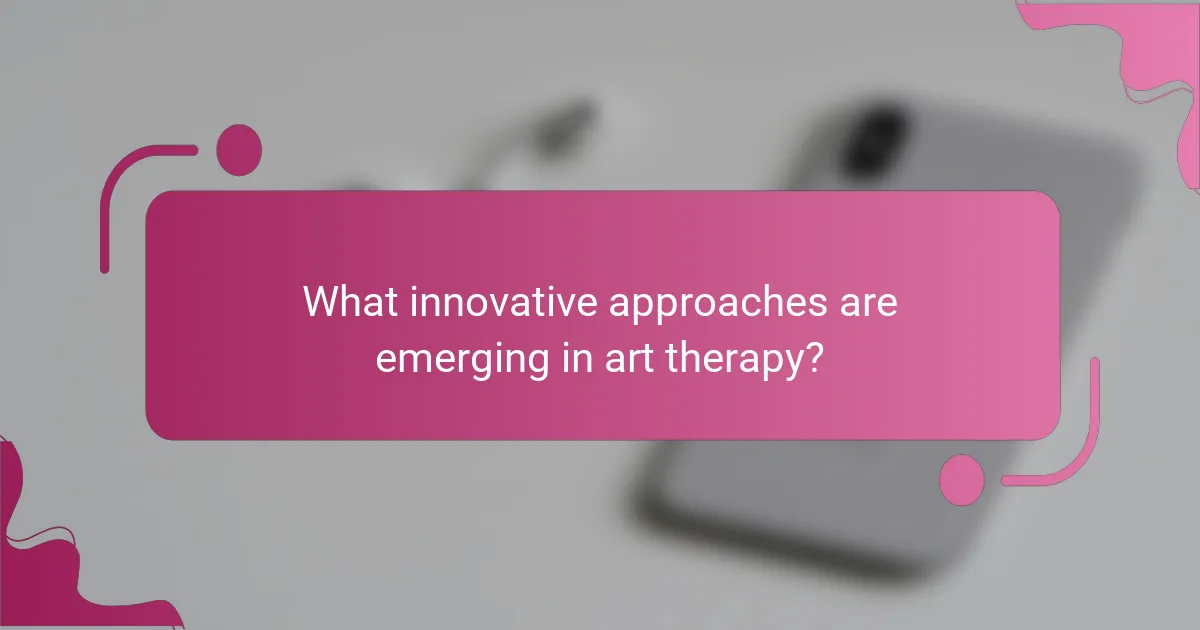
What innovative approaches are emerging in art therapy?
Innovative approaches in art therapy include digital art therapy, community-based projects, and integrative practices. Digital platforms enhance accessibility and engagement, allowing diverse populations to participate in therapeutic art-making. Community-based projects foster social connections and collective healing, emphasizing the role of shared experiences. Integrative practices combine traditional art therapy with mindfulness and movement, promoting emotional resilience through holistic methods. These approaches reflect a growing recognition of art’s potential in mental health and wellness.
How is technology being integrated into art therapy practices?
Technology is enhancing art therapy by integrating digital tools and platforms. Virtual reality (VR) allows immersive experiences, enabling clients to explore emotions in safe environments. Digital art applications facilitate creative expression, making art more accessible. Online therapy sessions broaden reach, connecting therapists and clients regardless of location. Wearable devices can monitor physiological responses, providing insights into emotional states. These innovations foster emotional resilience and self-expression in therapeutic practices.
What role do online platforms play in expanding access to art therapy?
Online platforms significantly enhance access to art therapy by offering remote sessions, resources, and community support. They allow individuals to engage in therapeutic practices regardless of geographical barriers. Many platforms provide various methods, such as guided art exercises and workshops, which promote healing and self-expression. Additionally, online communities foster emotional resilience by connecting users with shared experiences, enhancing the therapeutic process. This accessibility is crucial for those who may face challenges in accessing traditional therapy settings.
How can art therapy be adapted for virtual sessions?
Art therapy can be effectively adapted for virtual sessions by utilizing digital tools and platforms. Therapists can encourage clients to use art supplies they have at home, ensuring accessibility. Video conferencing allows for real-time interaction, fostering connection. Techniques such as guided imagery and mindfulness can be integrated into sessions to enhance emotional resilience. Additionally, sharing artwork through screen sharing or digital uploads promotes self-expression and feedback. These adaptations maintain the therapeutic benefits of art therapy while accommodating remote participation.
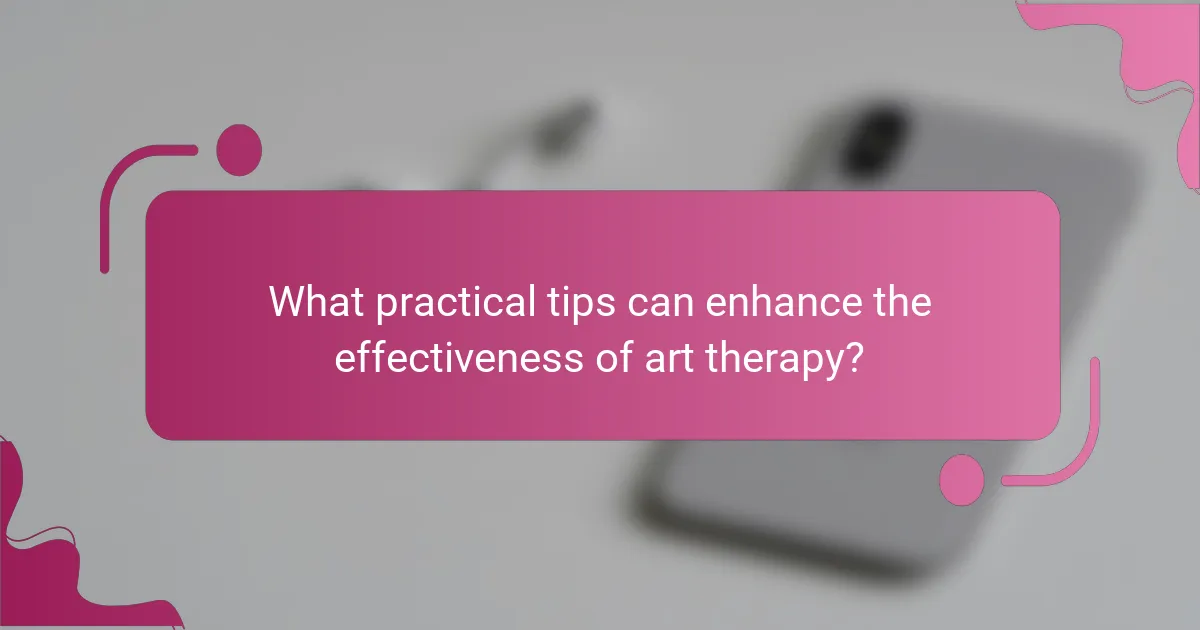
What practical tips can enhance the effectiveness of art therapy?
Engaging in art therapy can be enhanced through practical tips that foster creativity and emotional connection. Establish a comfortable workspace to encourage free expression. Use a variety of materials to explore different artistic techniques. Set specific intentions for each session to focus on particular emotions or experiences. Incorporate mindfulness practices to deepen the therapeutic process. Lastly, reflect on the artwork created to gain insight into feelings and thoughts.
How can clients best prepare for their art therapy sessions?
Clients can best prepare for their art therapy sessions by gathering materials and setting intentions. Bring preferred art supplies, such as paints, markers, or clay. Reflect on personal goals for the session, like exploring emotions or enhancing self-expression. Creating a comfortable environment can also enhance the experience. Dress in comfortable clothing and choose a space that feels safe and inspiring.
What common mistakes should clients avoid during art therapy?
Clients should avoid unrealistic expectations and resistance to the process during art therapy. Common mistakes include focusing solely on the final product instead of the experience, comparing their work to others, and neglecting to communicate feelings with the therapist. Additionally, clients may overlook the importance of regular participation, which can hinder progress. Embracing the therapeutic journey is essential for emotional resilience and self-expression.
Which materials are most beneficial for art therapy practices?
Art therapy practices benefit from a variety of materials that enhance creativity and emotional expression. Commonly used materials include acrylic paints, watercolors, pastels, clay, and mixed media. Each material offers unique attributes that facilitate different therapeutic outcomes. For instance, acrylic paints allow for vibrant colors and quick drying, which can encourage spontaneous expression. Clay provides a tactile experience that can promote grounding and mindfulness. Watercolors are often associated with fluidity and can help in exploring emotions gently. Pastels offer a soft texture that can evoke calmness and comfort. Using a diverse array of materials can significantly enhance the healing process in art therapy sessions.
